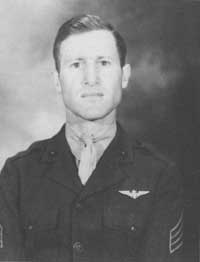HAMILTON-WILLIAM
WILLIAM JOHN HAMILTON

CAPT

A CORAGEOUS WAKE ISLAND DEFENDER
Wake Island is sometimes called the Alamo of the Pacific. It was attacked by the Japanese on December 8, 1941, at the same time as Pearl Harbor. Although the island was ultimately surrendered to the Japanese, Wake’s defense in 1941 was one of the few bright spots during the first months of war in the Pacific as it provided Americans a stirring example of heroism.
William John Hamilton was one of two Marine Corps enlisted pilots who participated in the defense of Wake. He was born on June 3, 1912, in Altoona, Pennsylvania, and after graduating from high school, he served in the U.S. Army Air Corps from 1930 to 1934. In 1935 he reportedly joined the Marine Corps, underwent pilot training at Pensacola, Florida, and was designated a Naval Aviation Pilot upon completion of his training on June 15, 1937. He was promoted to Corporal upon becoming a Marine Corps enlisted pilot, and in October 1937 was made a Sergeant. He was subsequently promoted to Technical Sergeant in May 1941. When World War II commenced, TSGT Hamilton was assigned to Marine Fighter Attack Squadron 211 (VMF-211) which had been moved in November 1941 to Wake to bolster the island’s defenses. The morning that Japanese aircraft commenced their attack on Wake, TSGT Hamilton was aloft with another plane piloting a Grumman F4F-3 Wildcat fighter performing a routine aerial search. Learning of the Japanese attack on Wake they were unsuccessful in finding the enemy until at about noon, descended through broken clouds about three miles from Wake, they spotted two formations of planes. He and his companion attempted unsuccessfully to catch the formation as they retired through the overcast and were forced to land shortly after noon to find destruction that defied description.
The following day, TSGT Hamilton and a second plane were in the air over Wake when a flight of 27 Japanese attacked. In the ensuing battle, he and his companion are believed to have shot down one of the bombers. On another day, TSGT Hamilton successfully strafed a Japanese cargo ship, igniting barrels of gasoline stowed in one of her holds. Historical records report that on returning to Wake, his Wildcat’s tail was perforated with numerous holes. By December 21, the last of the Wildcats had been destroyed in dogfights, and in addition to his flying duties, TSGT Hamilton joined several others in repairing damaged planes, including making engine changes and other major repairs. Unfortunately, on December 23 the overwhelming Japanese forces captured the island as the U.S. forces were forced to surrender. Later, TSGT Hamilton was singled out for “indefatigable labor, ingenuity, skill and technical knowledge.”
On December 23, 1941, TSGT Hamilton became a Japanese POW and was held captive until liberated on September 1, 1945. Historical records do not reveal where he was held as a POW but reflect he was married sometime prior to the war. He died on January 23, 1995, and is buried next to his wife at Quantico National Cemetery in Virginia where his grave marker carries the inscription: US ARMY AIR CORPS – CAPT US MARINE CORPS.
Submitted by CDR Roy A. Mosteller, USNR (Ret)

